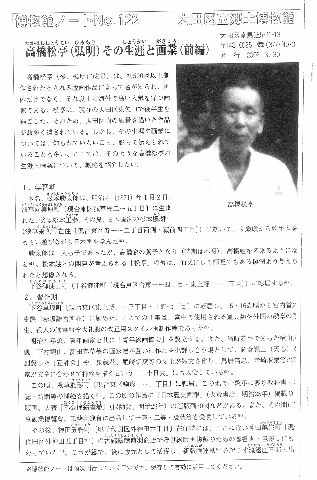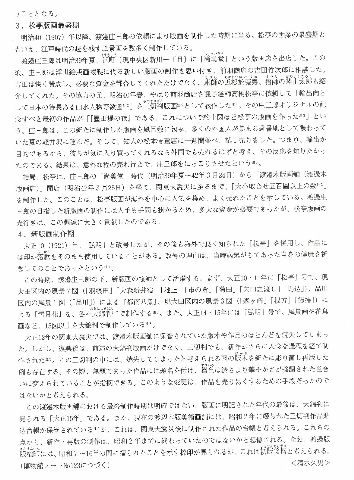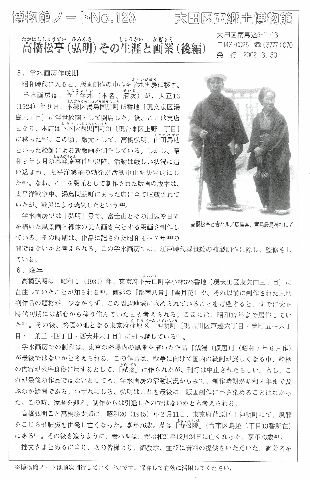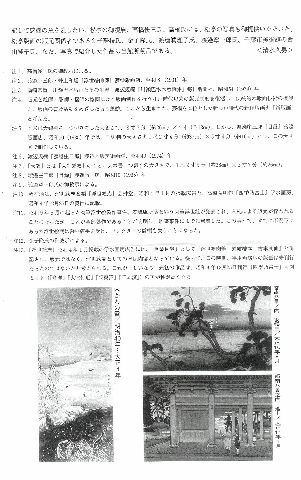|
Shôtei Biography The following material was published on March 30, 2002 by the Folk Museum of Ota City, Minami Magome 5-11-13, Ota-Ku Tokyo Japan. It was written by Mr. Shimizu Hisao and translated for Shotei.com by Mr. Koshinuma Tadashi. Museum Notes Number 122

Takahashi Shotei (Hiroaki) - His life and works - Part 1Takahashi Shotei (he later changed his name to Hiroaki) is famous, not only domestically but even more so abroad, because of over 500 woodblock print pictures that he made. Shotei lived the latter half of his life in Ota-Ku (Ota Ward) at the place currently named Higashi-Yaguchi. He designed many landscape prints of Ota-Ku. But, the history of his life and works is not well known, and there is much misinformation. Here I (Shimizu Hisao) will present an outline of Takahashi Shotei's life and works.1. Period of learningHis real name was Matsumoto Katsutaro. He was born January 2, 1871 (Meiji 4) at Asakusa muko-yanagiwara-machi (current place name: Asakusa-bashi 2-5 chome Taito-Ku Tokyo). His father was Matsumoto Masayasu. His uncle, Matsumoto Fuko (his father's elder brother), a Japanese style painter, taught Shotei by copybook starting when Shotei was 9 years old. Matsumoto Fuko lived at Asakusa-eikyu-cho (current place name: Kotobuki 1-2 chome, west side or Kuramae 4 chome Taito-Ku). Katsutaro was an only child, and was adopted into the Takahashi family at an unknown time and was thereafter known as Takahashi Katsutaro. I think that the pen name "Shotei" was given to him by his uncle as a variant of his own name "Matsumoto", since they both begin with the same Japanese character that can be pronounced either "Sho" or "Matsu".He changed his address to Shitaya-Okachimachi (current place name: Taito-Higashi 1-4 chome, Higashi-Ueno 1-2 chome, Taito-Ku) 2. Period of studyHe changed his address to Shitaya-Kurumazaka-cho (current place name: Higashi-Ueno 2-3 chome, Ueno 7 chome Taito-Ku). At the age of 15 or 16, he went to work in the Imperial Household Agency. His work was sketching of tools that were used in the Imperial Household Agency, foreign decorations, and making stylebooks of ordinary dress, court dress, etc.In about 1889 (Meiji 22), he established "Seinen Kaiga Kyokai" (Young Men's Picture Association) with his friends, young painters. Also, he had become a member of "Hatsuka-Kai" (Society of the 20th day), in which were novelist Izumi Kyoka, short story author Ozaki Koyo, and painters Torii Kiyotada and Terazaki Kogyo. These artists provided illustrations for the writing of the authors. He also became a member of "Gohyokai" (Society of Notice Each Other) that had been established by Okakura Kakuzo (Tenshin), in which (in those days they were young Japanese style painters) Yokoyama Taikan, Shimomura Kanzan, Hishida Shunso and other young painters had noticed the paintings of each other. He changed his address to Asakusa-Komagata-cho (current place name: Komagata 1-2 chome Taito-Ku). For more than 10 years, he designed illustrations of textbooks, magazines, newspapers, etc. In 1892 (Meiji 25), he designed woodblock prints for "Nippon Rekishi Gaho" (Illustrated magazine of Japanese history) published by Okura Shoten (Okura bookstore). In 1896 (Meiji 29) he designed about 30 lithographs of voluminous work "Hoko Iseki Emaki" (picture scroll of duties great achievements), published by Hokunkai (society of duties). Also during this time he received prizes (first prize, second prize, etc.) in various contests including "Tokyo Kangyo Hakurankai" (Tokyo Industrial Exhibition) and "Kogei Kyosinkai" (Industrial Exhibition). Later, when he lived at Kanda Gokencho (current place name: Chiyoda-Ku Soto Kanda 6 chome), he worked for Maeba Shoten. His duties included line drawing and separating the colors for reproduction of Ukiyo-e prints, and selling old "Nishiki-e" (color woodblock prints). Maeba Shoten was located at Kanda kamezumi-cho (current place name: Soto Kanda 6 chome Chiyoda-Ku), near where he lived. It was at Maeba Shoten where he met Watanabe Shozaburo who later became active as a publisher and started the Shin-hanga movement. 3. The golden age of ShoteiAfter 1907 (Meiji 40), he entered his "golden age" producing many landscape prints in the style of the Edo period for Watanabe. In 1906 (Meiji 39), Watanabe had opened a store of prints "Shobi-do" at Hama-cho (current place name: Shinkawa 1 chome Chuo-Ku). Those days Shozaburo made up his mind to produce new prints that would take the place of reproduction of Ukiyo-e prints, and he consulted Yoshida Takejiro of Maeba Shoten. Yoshida comfortably approved of him, and not only advanced the necessary money, but also introduced Watanabe to carver Chikamatsu Otoju and printer Ono Yoshitaro. Under this cooperation, in Spring of 1907, he requested painter Takahashi Shotei and he produced experimentally several prints of "Hills and rivers" and "Persons" (characteristically Japanese) for export. Their size was "mitsugiri-ban" (about 37cm x 16 cm). The first commemorative original product was "Sumida dike at night". "After that I produced about 10 prints of Shotei", Shozaburo said. Shozaburo wrapped these pictures in a kerchief and carried them to the summer resort Karuizawa where many foreigners gathered. For a trial period of a week, he attempted to sell the prints at the antique shop of his friend Matsumoto. Because his purpose was export, he thought that if they liked and bought the prints, they should go well in other countries. He wanted to know the reactions of the foreigners. The result was unexpectedly good, so he was happy.Shotei produced "over 500 prints" (small to large size) from the period of Shozaburo's "Shobi-do" (1906 through March 24, 1909) until the Great Kanto Earthquake (1923), through the opening of "Watanabe Mokuhangaten" (woodblock print shop). This fact indicates that Shotei's prints were popular in foreign countries and sold very well. Watanabe Shozaburo needed much money, because production of Shin-hanga demanded many hands and a lot of time. But, Shotei's prints, which sold very well, contributed to the supply of money. 4. Period of producing Shin-hangaIn 1921 (Taisho 10), Shotei changed his pen name to "Hiroaki", but he continued to use the seal or signature of "Shotei" whose name was well known in foreign countries. It is said that the reason for the change of his pen name was to pray for his health because at that time he was unwell.At this time, he was active as a designer of Shin-hanga for Watanabe Shozaburo. First, in 1921-2 (Taisho 10-11) he produced, under the pen name Shotei, the following onishiki size prints: seven landscapes of places now in Oto-Ku ("Haneda", "Ooi-arai-juku", "Ikegami", "Ichinokura", "Kamata", "Yaguchi-no-watashi", "Magome"), one of a scene now in Shinagawa-Ku ("Shinagawa" from the series "Eight Views of the Southern part of the Capital") and three places now in Ota-Ku ("Morigasaki", "Negata", "Tokumochi") from the series "Setsugekka" ("Snow, Moon, and Flowers). In 1925-6 (Taisho 14-15), using the name Hiroaki, he designed more than 15 other onishiki prints, including landscape and nature themes. After the Great Kanto Earthquake, in 1923 (Taisho 12), almost all works and woodblocks kept in Watanabe Mokuhangaho (woodblock print shop) were burned and destroyed. But, after reconstruction, new prints were produced (both onishiki-ban and mitsugiri-ban) in a more elaborate process. Some of the destroyed mitsugiri-ban blocks were re-carved. I can point out examples, in those cases, where titles were added to prints previously without a title and brighter colors replaced previously subdued ones. I think that this change was intended to increase sales. It is not clear when his last print for Watanabe appeared. The latest known date is that of 1926 (Taisho 15), which appears on an onishiki-ban design. Also, in the Watanabe woodprint museum a ledger is preserved that records production of mitsugiri-ban prints up through 1927 (Showa 2); this appears to be a record of prints produced after the Great Kanto Earthquake. Considering these points, I guess the production of new prints and reprints of the old designs had ceased by 1928. Furthermore, although we can see seals of Wantanabe's copyright on prints that indicate they were printed from 1933-1942 (Showa 7-16), it is assumed that they are later printings from the original blocks. Museum Notes Number 123

Takahashi Shotei (Hiroaki) - His life and works - Part 25. Period of production at Fusui-gaboIn Showa period, Shotei moved core of producing prints to Fusui-gabo (Fusui art house). Fusui-gabo was opened as an Ukiyo-e shop by Kaneko Fusui (real name is Kaneko Seiji) in September, 1924 (Taisho 13) at Yushima-doho-cho 15, Hongo-Ku (current place name: Yushima 3 chome, Bunkyo-Ku). Later that shop was changed to branch and the head shop moved to Nishi-kuromon-cho 21, Shitaya-Ku (current place name: Ueno 1 chome, Taito-Ku). In those days, he published Shin-hanga of painters Takahashi Hiroaki and Yamada Basuke. But, after the Shunpo-an affair in 1934 (Showa 9), his activity was driven into difficulty, and at the outbreak of the Pacific War his business ended. It is said that all of the woodblocks for prints that were produced here, kept in the branch at Yushima-doho-cho, were burned by war damage of the Pacific War.At Fusui-gabo, he used the name Hiroaki, producing prints that were mainly landscapes of Mt. Fuji, scenes around Mt. Fuji, Nikko, and beautiful girls in the nude. I consider that period is between 1929 and 1932 (Showa 4 and 7) as printed on his works. At Fusui-gabo, he was also chief editor for their reproductions of Edo era Ukiyo-e prints. 6. Later yearsIt is known that Takahashi Hiroaki lived at Kobayashi 326 Shimoyaguchi-cho, Tokyo-Fu (current place name: Higashi-yaguchi 2 chome Ota-Ku) in 1931 (Showa 6). Because the "Eight Views of the Southern Part of the Capital" and "Setsugekka" series of onishiki-ban prints and many subjects of mitsugiri-ban were based near here, it might be assumed that he already had moved here from the center of Tokyo in the Taisho or early Showa period. He lived here until 1942 (Showa 17). Later he moved to Kami-shinmei-cho Ebara-Ku Tokyo-Fu (current place name: Totsuka 6 chome, Yutaka cho 508 chome, Futaba 3-4 chome, Nishi-oi 6 chome Shinagawa-Ku) where he died.I think his last production at Fusui-gabo was "Sento (tentative title)" (public bath) produced in June, 1932 (Showa 7). Although a trial print was produced, this work was probably censored, because the contents of the design violated public order and standards of decency, during the period of strong governmental control of the pre-War years. Even if this was not the last work, I doubt he produced after 1933 (Showa 8), because of activity of Fusui-gabo. In any case, Hiroaki did not produce any more prints. I think that when he got 60 years old, in 1931 (Showa 6), he retired from producing prints. Takahashi Shotei (real name Takahashi Katsutaro) caught cold, then pneumonia and died on February 11, 1945 (Showa 20) at Kami-shinmei-cho Ebara-Ku, Tokyo-Fu, 76 years old. Gravestone is at "Jushoin" (Torigoe 1 chome 13 Taito-Ku). His wife Haru died on December 24, 1946 (Showa 21), 73 years old. I was supported with materials and information for this report from Shotei's family, Mr. Takahashi Shunzo, who offered me Shotei's photographs. Also by Kaneko Shizue, Kaneko Takashi, Watanabe Mariko, Watanabe Shoichiro (concerned at local). Photographs of his works are from the collection of this Folk Museum. The works pictured here are:
Written by Shimizu Hisao Translated by Koshinuma Tadashi (K Art Museum) CommentaryI want to thank Mr. Koshinuma Tadashi, of the K Art Museum, for finding these 2 numbers of the Ota City Folk Museum's Museum Notes and for bringing them to my attention. He graciously agreed to translate the text to English, so that it could be posted here and made available to all who want to study the life and works of Takahashi Shotei. Koshinuma-san, thank you very much! This document is an important one. Having been researched with the artist's descendants, much of the information it contains must be looked on as being definitive. The photographs of Shotei are the only ones that I have seen published. Information which is "new" includes:
However, the above document is perhaps not entirely complete. It omits Hiroaki's association with the publisher Shobido Tanaka, for whom he designed 180 prints. The Shobido catalog of which I have a copy was acquired from the publisher in Spring, 1940. There are small format prints (ST-179 and ST-180) produced by Shobido and signed by Hiroaki that were not in that catalog, implying that he was designing prints for Shobido during or after 1940. Also, Shimizu-san's assertion that Shotei didn't design any prints for Watanabe after 1927 just doesn't seem to fit in with the prints listed in Watanabe's 1936 and 1951 catalogs. In the 1936 catalog, there were 16 oban (or larger) prints listed. By the time of the 1951 Watanabe catalog, 2 more prints ("Mt. Fuji from Midzukubo" and "Camellia and Puppy in Snow", O-17 and O-18) had been added to Watanabe's inventory. Those prints had to have been produced sometime between 1936 and Shotei's death in 1945. Therefore, I question whether the statement "when he got 60 years old, in 1931 (Showa 6), he retired from producing prints" is valid. Perhaps we'll never know for sure, but my own thought is that he was productive as a print designer until at least 1940. Commentary by Marc Kahn | |
|
| |
| Home | Copyright 2002 by Marc Kahn; All Rights Reserved |